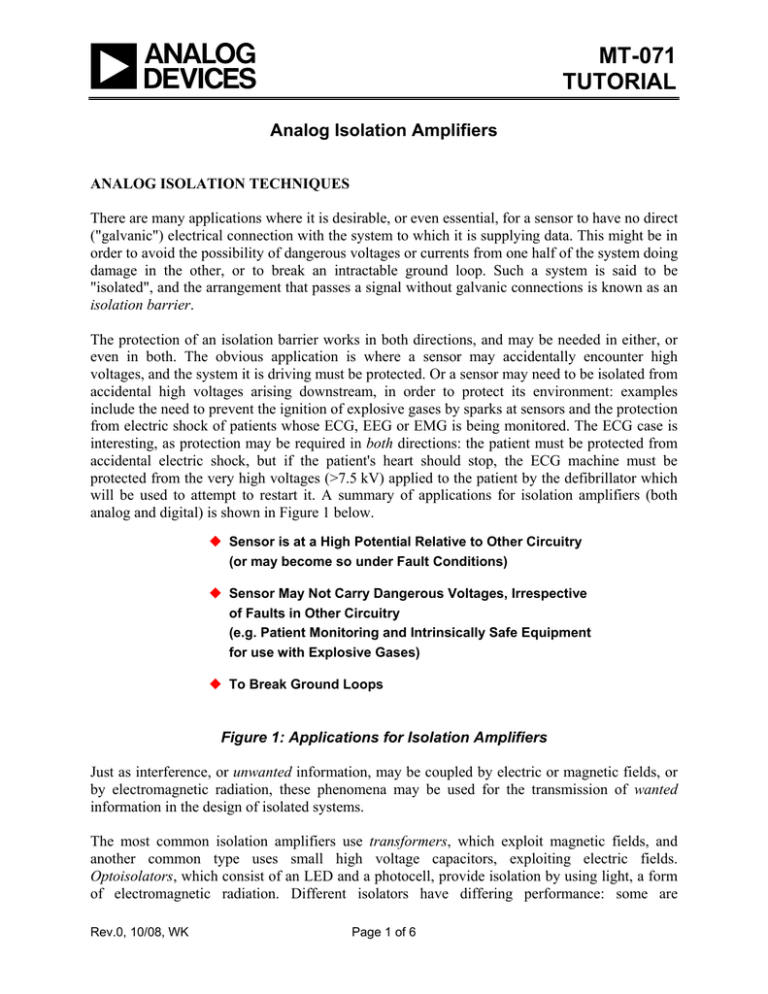MT-071 TUTORIAL Analog Isolation Amplifiers
advertisement

MT-071 TUTORIAL Analog Isolation Amplifiers ANALOG ISOLATION TECHNIQUES There are many applications where it is desirable, or even essential, for a sensor to have no direct ("galvanic") electrical connection with the system to which it is supplying data. This might be in order to avoid the possibility of dangerous voltages or currents from one half of the system doing damage in the other, or to break an intractable ground loop. Such a system is said to be "isolated", and the arrangement that passes a signal without galvanic connections is known as an isolation barrier. The protection of an isolation barrier works in both directions, and may be needed in either, or even in both. The obvious application is where a sensor may accidentally encounter high voltages, and the system it is driving must be protected. Or a sensor may need to be isolated from accidental high voltages arising downstream, in order to protect its environment: examples include the need to prevent the ignition of explosive gases by sparks at sensors and the protection from electric shock of patients whose ECG, EEG or EMG is being monitored. The ECG case is interesting, as protection may be required in both directions: the patient must be protected from accidental electric shock, but if the patient's heart should stop, the ECG machine must be protected from the very high voltages (>7.5 kV) applied to the patient by the defibrillator which will be used to attempt to restart it. A summary of applications for isolation amplifiers (both analog and digital) is shown in Figure 1 below. Sensor is at a High Potential Relative to Other Circuitry (or may become so under Fault Conditions) Sensor May Not Carry Dangerous Voltages, Irrespective of Faults in Other Circuitry (e.g. Patient Monitoring and Intrinsically Safe Equipment for use with Explosive Gases) To Break Ground Loops Figure 1: Applications for Isolation Amplifiers Just as interference, or unwanted information, may be coupled by electric or magnetic fields, or by electromagnetic radiation, these phenomena may be used for the transmission of wanted information in the design of isolated systems. The most common isolation amplifiers use transformers, which exploit magnetic fields, and another common type uses small high voltage capacitors, exploiting electric fields. Optoisolators, which consist of an LED and a photocell, provide isolation by using light, a form of electromagnetic radiation. Different isolators have differing performance: some are Rev.0, 10/08, WK Page 1 of 6 MT-071 sufficiently linear to pass high accuracy analog signals across an isolation barrier. With others, the signal may need to be converted to digital form before transmission for accuracy is to be maintained (note this is a common voltage-to-frequency converter application). Transformers are capable of analog accuracy of 12-16 bits and bandwidths up to several hundred kHz, but their maximum voltage rating rarely exceeds 10 kV, and is often much lower. Capacitively-coupled isolation amplifiers have lower accuracy, perhaps 12-bits maximum, lower bandwidth, and lower voltage ratings—but they are low cost. Optical isolators are fast and cheap, and can be made with very high voltage ratings (4 -7 kV is one of the more common ratings), but they have poor analog linearity, and are not usually suitable for direct coupling of precision analog signals. Linearity and isolation voltage are not the only issues to be considered in the choice of isolation systems. Operating power is of course, essential. Both the input and the output circuitry must be powered, and unless there is a battery on the isolated side of the isolation barrier (which is possible, but rarely convenient), some form of isolated power must be provided. Systems using transformer isolation can easily use a transformer (either the signal transformer or another one) to provide isolated power, but it is impractical to transmit useful amounts of power by capacitive or optical means. Systems using these forms of isolation must make other arrangements to obtain isolated power supplies—this is a powerful consideration in favor of choosing transformer isolated isolation amplifiers: they almost invariably include an isolated power supply. The isolation amplifier has an input circuit that is galvanically isolated from the power supply and the output circuit. In addition, there is minimal capacitance between the input and the rest of the device. Therefore, there is no possibility for dc current flow, and minimum ac coupling. Isolation amplifiers are intended for applications requiring safe, accurate measurement of low frequency voltage or current (up to about 100 kHz) in the presence of high common-mode voltage (to thousands of volts) with high common mode rejection. They are also useful for linereceiving of signals transmitted at high impedance in noisy environments, and for safety in general-purpose measurements, where dc and line-frequency leakage must be maintained at levels well below certain mandated minimums. Principal applications are in electrical environments of the kind associated with medical equipment, conventional and nuclear power plants, automatic test equipment, and industrial process control systems. AD210 3-PORT ISOLATOR In a basic two-port form of isolator, the output and power circuits are not isolated from one another. A three-port isolator (input, power, output) is shown in Figure 2 below. Note that in this diagram, the input circuits, output circuits, and power source are all isolated from one another. This figure represents the circuit architecture of a self-contained isolator, the AD210. An isolator of this type requires power from a two-terminal dc power supply (PWR, PWR COM). An internal oscillator (50 kHz) converts the dc power to ac, which is transformer-coupled to the shielded input section, then converted to dc for the input stage and the auxiliary power output. Page 2 of 6 MT-071 FB –IN +IN INPUT T1 _ + OUTPUT _ DEMOD FILTER MOD + ICOM +VISS –VISS VO OCOM POWER T2 INPUT POWER SUPPLY T3 OUTPUT POWER SUPPLY +VOSS –VOSS POWER OSCILLATOR PWR PWR COM Figure 2: AD210 3-Port Isolation Amplifier The ac carrier is also modulated by the input stage amplifier output, transformer-coupled to the output stage, demodulated by a phase-sensitive demodulator (using the carrier as the reference), filtered, and buffered using isolated dc power derived from the carrier. The AD210 allows the user to select gains from 1 to 100, using external resistors with the input section op amp. Bandwidth is 20 kHz, and voltage isolation is 2500 V rms (continuous) and ± 3500 V peak (continuous). The AD210 is a 3-port isolation amplifier, thus the power circuitry is isolated from both the input and the output stages and may therefore be connected to either (or to neither), without change in functionality. It uses transformer isolation to achieve 3500 V isolation with 12-bit accuracy. Key specifications for the AD210 are summarized in Figure 3 below. Transformer Coupled High Common Mode Voltage Isolation: z 2500V RMS Continuous z ±3500V Peak Continuous Wide Bandwidth: 20kHz (Full Power) 0.012% Maximum Linearity Error Input Amplifier: Gain 1 to 100 Isolated Input and Output Power Supplies, ±15V, ±5mA Figure 3: AD210 Isolation Amplifier Key Specifications Page 3 of 6 MT-071 MOTOR CONTROL ISOLATION AMPLIFIER APPLICATION A typical isolation amplifier application using the AD210 is shown in Figure 4 below. The AD210 is used with an AD620 instrumentation amplifier in a current-sensing system for motor control. The input of the AD210, being isolated, can be directly connected to a 110 or 230 V power line without protection being necessary. The input section's isolated ±15 V powers the AD620, which senses the voltage drop in a small value current sensing resistor. The AD210 input stage op amp is simply connected as a unity-gain follower, which minimizes its error contribution. The 110 or 230 V rms common-mode voltage is ignored by this isolated system. HIGH VOLAGE AC INPUT < 2500V RMS +15V RG 0.01Ω –IN +IN AD620 REF _ INPUT FB + T1 _ + OUTPUT _ DEMOD FILTER MOD + OUTPUT VO OCOM ICOM –15V +VISS –VISS M RG = 499Ω FOR G = 100 POWER T2 T3 INPUT POWER SUPPLY OUTPUT POWER SUPPLY +VOSS –VOSS POWER OSCILLATOR AD210 PWR PWR COM +15V Figure 4: Motor Control Current Sensing Application Within this system the AD620 preamp is used as the system scaling control point, and will produce and output voltage proportional to motor current, as scaled by the sensing resistor value and gain as set by the AD620's RG. The AD620 also improves overall system accuracy, as the AD210 VOS is 15 mV, versus the AD620's 30 µV (with less drift also). Note that if higher dc offset and drift are acceptable, the AD620 may be omitted and the AD210 connected at a gain of 100. Due to the nature of this type of carrier-operated isolation system, there will be certain operating situations where some residual ac carrier component will be superimposed upon the recovered output dc signal. When this occurs, a low impedance passive RC filter section following the output stage may be used (if the following stage has a high input impedance, i.e., non-loading to this filter). Note that will be the case for many high input impedance sampling ADCs, which appear essentially as a small capacitor. A 150 Ω resistance and 1 nF capacitor will provide a corner frequency of about 1 kHz. Note also that the capacitor should be a film type for low errors, such as polypropylene. Page 4 of 6 MT-071 AD215 TWO-PORT ISOLATOR The AD215 is a high speed, two-port isolation amplifier, designed to isolate and amplify wide bandwidth analog signals. The innovative circuit and transformer design of the AD215 ensures wide-band dynamic characteristics, while preserving dc performance specifications. An AD215 block diagram is shown in Figure 5 below. Figure 5: AD215 120kHz Low Distortion 2-Port Isolation Amplifier The AD215 provides complete galvanic isolation between the input and output of the device, which also includes the user-available front-end isolated bipolar power supply. The functionally complete design, powered by a ±15 V dc supply on the output side, eliminates the need for a user supplied isolated dc/dc converter. This permits the designer to minimize circuit overhead and reduce overall system design complexity and component costs. The design of the AD215 emphasizes maximum flexibility and ease of use in a broad range of applications where fast analog signals must be measured under high common-mode voltage (CMV) conditions. The AD215 has a ±10 V input/output range, a specified gain range of 1 V/V to 10 V/V, a buffered output with offset trim and a user-available isolated front end power supply which produces ±15 V dc at ±10 mA. The key specifications of the AD215 are summarized in Figure 6 below. Isolation voltage: 1500V rms Full power bandwidth: 120kHz Slew rate: 6V / µs Harmonic distortion: –80dB @ 1kHz 0.005% maximum linearity error Gain range: 1 to 10 Isolated input power supply: ±15V @ ±10mA Figure 6: AD215 Isolation Amplifier Key Specifications Page 5 of 6 MT-071 REFERENCES 1. Hank Zumbahlen, Basic Linear Design, Analog Devices, 2006, ISBN: 0-915550-28-1. Also available as Linear Circuit Design Handbook, Elsevier-Newnes, 2008, ISBN-10: 0750687037, ISBN-13: 9780750687034. Chapter 2. 2. Walter G. Jung, Op Amp Applications, Analog Devices, 2002, ISBN 0-916550-26-5, Also available as Op Amp Applications Handbook, Elsevier/Newnes, 2005, ISBN 0-7506-7844-5. Chapter 2. 3. Charles Kitchin and Lew Counts, A Designer's Guide to Instrumentation Amplifiers, 3rd Edition, Analog Devices, 2006. Copyright 2009, Analog Devices, Inc. All rights reserved. Analog Devices assumes no responsibility for customer product design or the use or application of customers’ products or for any infringements of patents or rights of others which may result from Analog Devices assistance. All trademarks and logos are property of their respective holders. Information furnished by Analog Devices applications and development tools engineers is believed to be accurate and reliable, however no responsibility is assumed by Analog Devices regarding technical accuracy and topicality of the content provided in Analog Devices Tutorials. Page 6 of 6




